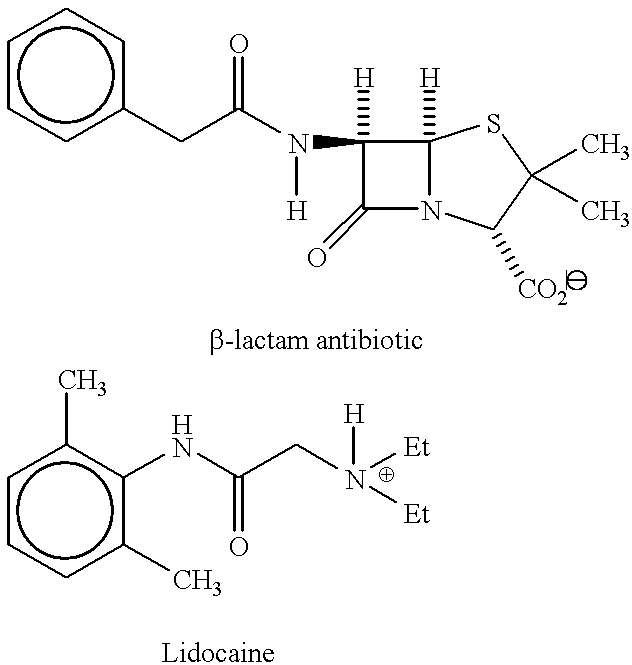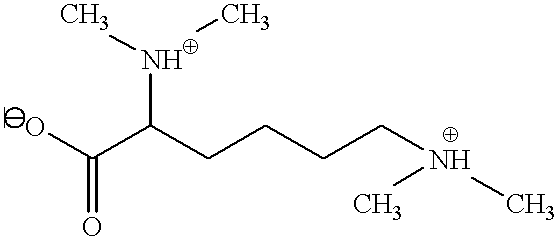Inorganic-polymer complexes for the controlled release of compounds including medicinals
a technology of inorganic polymer complexes and compounds, applied in the direction of inorganic non-active ingredients, drug compositions, prosthesis, etc., can solve the problems of high cost of antibiotics for systemic use, unsatisfactory systemic antibiotic treatment, and the selection of drug-resistant mutants, so as to reduce the systemic use of antibiotics
- Summary
- Abstract
- Description
- Claims
- Application Information
AI Technical Summary
Benefits of technology
Problems solved by technology
Method used
Image
Examples
example 1
Preparation of a radiopague norfloxacin-inorganic-biopolymer complex
CaSO.sub.4.1 / 2H.sub.2 O is sterilized by heating at 120.degree. C. for 4 hours and then divided into 1 g aliquots which are stored in individual plastic containers in a desiccator. Calcium sulfate(1 mg), 50 mg norfloxacin, and 110 mg iodipamide, all finely ground, are mixed thoroughly. To this mixture is added 0.6 ml of cold hyaluronic acid solution (2%). The slurry is mixed to an even consistency and is loaded into the barrel of a 3 ml syringe with a spatula. The plunger is replaced and the air expelled. The needle is attached to the syringe and the inorganic-biopolymer complex is ready for administration or casting in a mold.
example 2
Preparation of Lidocaine Matrix
calcium sulfate-hemihydrate (1 g) was mixed with finely ground dextran (clinical grade, 0.2 g) and lidocaine (1 g). The solid mixture was then stirred with 0.6 ml of water or alternatively 0.6 ml of HA (2%). The slurry was apportioned into screw-capvials, 0.2 ml each. After 24 hr. at room temperature, the samples were refrigerated. The release experiments were done at 37.degree. C. using 1 ml of buffer per vial with changes at 24 hr. intervals. The release buffer was PBS containing 0.1% sodium azide. The concentration of lidocaine was determined spectrophotometrically (260 nm). See Table 3 below
example 3
Preparation of an Inorganic-biopolymer Complex Containing Bound and Free Amikacin
Chondroitin sulfate solution (sodium salt, 5%) is converted to the acid form by passage over a column of DOWEX-50 (sulfonated polystrene). Assuming a residue molecular weight of 500, a stoichiometric amount of amikacin free base is added at 0-4.degree. C. The H is adjusted to 7 and the product is frozen. Alternatively, the product is freeze-dried and stored in a desiccator. Using chondroitin sulfate as the medicinal complexing agent, other complexes can be made by this procedure. Lidocaine, morphine, gentamicin, clindamycin, and doxorubicin are examples.
Calcium sulfate (1 g) is thoroughly mixed with 50 mg of chondroitin sulfate-amikacin (above) and 25 mg amikacin sulfate(1:2). Hyaluronic acid solution (0.6 ml, 2%) is added and the mixture handled as described in Example 1.
PUM
| Property | Measurement | Unit |
|---|---|---|
| temperatures | aaaaa | aaaaa |
| time period | aaaaa | aaaaa |
| residence time | aaaaa | aaaaa |
Abstract
Description
Claims
Application Information
 Login to View More
Login to View More - R&D
- Intellectual Property
- Life Sciences
- Materials
- Tech Scout
- Unparalleled Data Quality
- Higher Quality Content
- 60% Fewer Hallucinations
Browse by: Latest US Patents, China's latest patents, Technical Efficacy Thesaurus, Application Domain, Technology Topic, Popular Technical Reports.
© 2025 PatSnap. All rights reserved.Legal|Privacy policy|Modern Slavery Act Transparency Statement|Sitemap|About US| Contact US: help@patsnap.com



